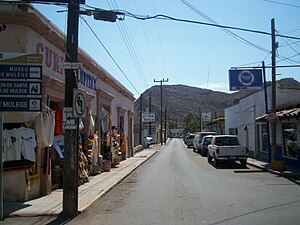Mulegé
|
Mulegé Heroica Mulegé |
|
|---|---|

Street in town
|
|
| Location in Mexico | |
| Coordinates: 26°53′30″N 111°58′51″W / 26.89167°N 111.98083°WCoordinates: 26°53′30″N 111°58′51″W / 26.89167°N 111.98083°W | |
| Country |
|
| State | Baja California Sur |
| Municipality | Mulegé |
| Elevation | 52 ft (16 m) |
| Population (2010) | |
| • City | 3,821 |
| • Urban | 3,821 |
| Time zone | Pacific (US Mountain) (UTC-7) |
| • Summer (DST) | Pacific (UTC-6) |
Mulegé is an oasis town in the Mexican state of Baja California Sur, situated at the mouth of the Río de Santa Rosalía. It is the fourth-largest community in Mulegé Municipality. It had a population of 3,821 according to the Mexican federal census of 2010.
Indigenous peoples had lived in this area for thousands of years due to the abundance of water in the river valley. Extensive ancient cave paintings can be found in the nearby Sierra de Guadalupe mountains.
In 1702, Jesuit Father Juan Maria de Salvatierra identified the valley of today's Mulegé as a place for a mission to the Indians. It was not until 1754 that Father Francisco Escalante started the construction of the mission, called Misión Santa Rosalía de Mulegé. Years later, many other Jesuit fathers came into today's area of Mulegé to bring the Catholic faith and convert the natives to Catholicism.
The official name of the town is "Heroica Mulegé." This title is based on incidents during the Mexican-American War of 1846-1848. The Americans tried to occupy long stretches of the Pacific coast such as California, Baja California, and New Mexico – all of which were then part of Mexico. The people of Mulegé and surrounding settlements along the Pacific coastline defeated the Americans. As a result, Mulegé was not occupied and was rewarded the official title "Heroica Mulegé" by the national legislature. In the 21st century, official letters of the Government of Baja California Sur retain use of the title, "Heroica Mulegé."
Mulegé is internationally famous for its rich fishing grounds in the Gulf of California. A warm current from the southern and a cold current from the northern Pacific come together in the Mulegé area of the Gulf of California and encourage a great variety of different fish species. The Gulf is sometimes known as the "Sea of Cortez", after the Spanish explorer, Hernán Cortés, who sailed into the area.
In the past, Mulegé's economy was largely based on fishing and farming. Today, tourism is a major income source for Mulegé. Some come for the area's deep sea fishing. Kayaking; cave tours; bird watching; and fishing, with or without charters to catch a big game fish; are popular attractions.
...
Wikipedia

